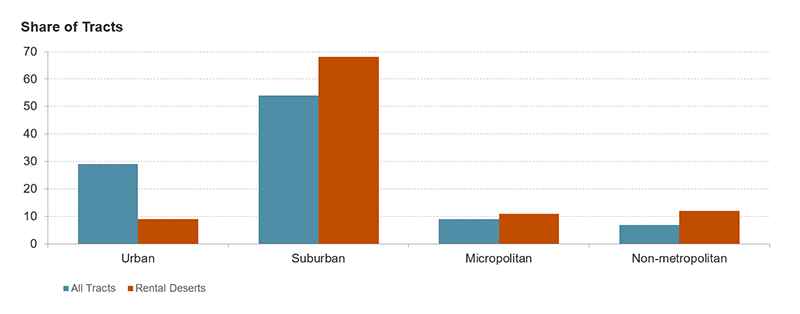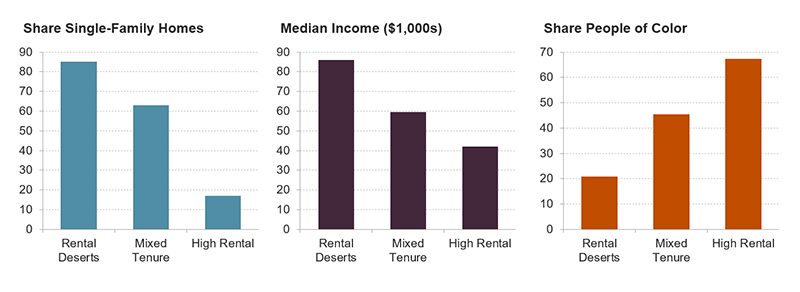Rental Deserts Perpetuate Socioeconomic and Racial Segregation
Nearly a third of neighborhoods across the country have few options for renters, and these places are disproportionately suburban, higher-income, and have a higher share of white households, according to a new analysis of the most recently available data from the 2015–2019 American Community Survey. Exclusionary land use quite likely contributes to the presence of these rental deserts and the resulting patterns of socioeconomic and racial segregation, since renters are disproportionately lower-income and people of color. Recent zoning changes in several states and communities across the country have the potential to increase housing options for renters.
In recent Center reports, we developed the concept of rental deserts to highlight places that have few rental opportunities for households. In these neighborhoods, less than 20 percent of housing units are either occupied by a renter or are vacant for rent. In contrast, high-rental areas are at least 80 percent rentals, while mixed-tenure neighborhoods fall in between the two. Our analysis examines the geography and characteristics of rental deserts, showing how the absence of rental opportunities reinforces socioeconomic and racial segregation.
Rental deserts make up about 31 percent of all neighborhoods nationally. This amounts to more than 22,000 census tracts where less than 20 percent of the stock is available to renters. Among these, nearly 7,000 are extreme rental deserts where just 10 percent of the stock or less is renter-occupied or vacant for rent. At the other end of the spectrum, high-rental neighborhoods make up just 5 percent of all tracts.
Rental deserts are disproportionately located in the suburbs where restrictive land use regulations and not-in-my-backyard (NIMBY) politics can be common. In fact, suburban neighborhoods in metropolitan areas make up 54 percent of all tracts but account for 68 percent of rental deserts (Figure 1). Conversely, 29 percent of all tracts are in urban areas of major metros, but these neighborhoods make up just 9 percent of rental deserts. An additional 11 percent of rental deserts are in smaller micropolitan areas, while the remaining 12 percent fall outside of metro or micro areas that tend to be more rural, making rental deserts slightly more prevalent in these areas.
Figure 1: Rental Deserts Are Disproportionately Located in Suburban Areas
Notes: Urban and suburban tracts fall within metropolitan statistical areas. Micropolitan areas have populations between 10,000 and 50,000. Non-metropolitan tracts fall outside of metropolitan or micropolitan areas.
Source: Author tabulations of US Census Bureau, 2015-2019 American Community Survey Estimates.
Single-family homes are much more common in rental deserts, which is unsurprising given that single-family homes have higher homeownership rates than units in multifamily buildings. In the median neighborhood, a full 85 percent of homes in rental deserts are a single unit, compared to 63 percent in mixed-tenure neighborhoods and 17 percent in neighborhoods that are predominantly rentals (Figure 2). While single-family units can be converted to rentals and an increasing number are built as rentals, the lack of multifamily homes in these neighborhoods is likely a significant factor in limiting opportunities for renter households and for lower-income renters in particular.
Figure 2: Rental Deserts Have More Single-Family Homes, Higher Median Incomes, and Fewer People of Color
Notes: In rental deserts, less than 20 percent of the housing stock is for rent or renter occupied. High rental neighborhoods are at least 80 percent for rent or renter occupied. Mixed tenure neighborhoods are between 20 and 80 percent for rent or renter occupied. Figures shown are neighborhood medians.
Source: Author tabulations of US Census Bureau, 2015-2019 American Community Survey Estimates.
By limiting the number of rental options, neighborhoods effectively exclude lower-income households from their communities. With few affordable options for lower-income renters, the median household income in rental deserts is $86,000. Median incomes in high-rental neighborhoods, however, are less than half that at $42,000, while mixed-tenure neighborhoods fall in the middle at about $60,000.
The concentration of the rental stock also contributes to segregation by race and ethnicity, as people of color are more likely to be renters. Due to longstanding and ongoing discrimination in education and the labor market, Black and Hispanic households have lower median incomes than white households and less generational wealth to draw from, limiting the resources available for a downpayment and contributing to their relatively higher rentership rates. Moreover, centuries of racially discriminatory government policies and practices, as well as discrimination in the housing and homebuying market, have denied households of color, and Black households in particular, access to homeownership opportunities.
The legacy of these deep-rooted inequities is evident in the low shares of people of color in rental deserts. While people of color headed 67 percent of households in high-rental neighborhoods, less than 21 percent of households were headed by a person of color in rental deserts. High-rental neighborhoods also had four times the share of households headed by a Black or Hispanic person than rental desert neighborhoods. In contrast, rental desert neighborhoods had more than twice the share of white households (79 percent) as high-rental neighborhoods (33 percent).
The lack of rental options in many neighborhoods across the country reinforces enduring patterns of residential segregation. Increasing the multifamily supply and increasing rental options in neighborhoods where few exist can help expand the geographic options available to renters, and reducing zoning barriers is a step in the right direction. As noted in The State of the Nation’s Housing 2022, several states and communities recently enacted zoning changes to allow for more types of housing in areas that were previously zoned exclusively for single-family homes. For example, in 2021 Massachusetts enacted a new requirement that the 175 communities served by the Massachusetts Bay Transit Authority have at least one zoning district that permits multifamily housing by right. These zoning changes could increase the number of rental options available in desirable locations and reduce the number of rental deserts.
But zoning changes and increased multifamily housing alone is not enough to confront persistent inequities in where people can live. Building homes at lower price points and expanding housing subsidies in a range of neighborhoods will also be necessary to create socioeconomically integrated, mixed-tenure communities.



